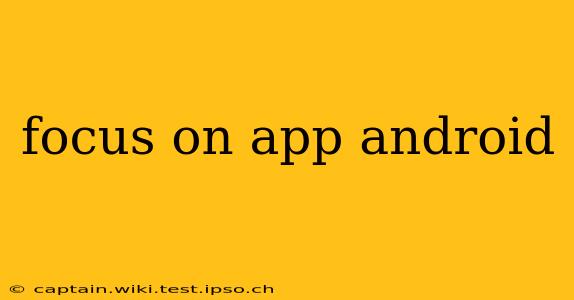The Android operating system powers billions of devices globally, making it a dominant force in the mobile landscape. This vast ecosystem isn't just about phones; it extends to tablets, wearables, and even automobiles. Understanding the intricacies of Android apps, from development to user experience, is crucial for developers, businesses, and users alike. This comprehensive guide delves into the heart of Android app development and usage, exploring key aspects and answering frequently asked questions.
What Makes Android Apps Unique?
Android's open-source nature is a defining characteristic. Unlike iOS, which is tightly controlled by Apple, Android allows for a much greater degree of customization and flexibility. This openness fosters innovation, resulting in a diverse range of apps catering to a broad spectrum of needs and preferences. The vast hardware landscape supported by Android also contributes to its uniqueness; apps need to be designed to function seamlessly across a wide array of screen sizes, resolutions, and processing power. This necessitates robust testing and adaptive design principles.
How Are Android Apps Developed?
Android app development primarily involves using Java, Kotlin, or C++. These programming languages, combined with the Android Software Development Kit (SDK), allow developers to build applications tailored to the Android platform. The development process typically involves designing the user interface (UI), writing the code for app functionality, testing the app rigorously on various devices and emulators, and finally, publishing the app on the Google Play Store. This process requires a strong understanding of programming principles, design thinking, and the Android SDK's capabilities.
What are the Different Types of Android Apps?
The Android app landscape is incredibly diverse. We can categorize them broadly as:
- Native Apps: Built specifically for Android using Java, Kotlin, or C++, offering optimal performance and access to device features.
- Hybrid Apps: Developed using frameworks like React Native or Flutter, combining elements of native and web apps. They offer cross-platform development capabilities but might compromise on performance compared to native apps.
- Web Apps: Accessible through a web browser, offering easy access but limited access to device features.
Each type has its strengths and weaknesses, making the choice dependent on project requirements and budget constraints.
What are the Key Features of a Good Android App?
A successful Android app needs more than just functionality; it requires a holistic user experience. Key features include:
- Intuitive User Interface (UI) and User Experience (UX): Easy navigation, clear visual hierarchy, and a consistent design language are paramount.
- Seamless Performance: The app should be responsive and free of bugs, ensuring a smooth user experience.
- Regular Updates: Addressing bugs, adding new features, and improving security are vital for maintaining user engagement.
- Security: Protecting user data and adhering to security best practices are crucial for building trust.
How Can I Monetize My Android App?
Monetizing an Android app can be achieved through several strategies:
- In-app Purchases: Offering virtual goods, premium features, or subscriptions.
- Advertisements: Displaying ads within the app, either through banners or interstitial ads.
- Freemium Model: Offering a basic version for free and charging for premium features.
- Subscription Model: Providing ongoing access to features or content for a recurring fee.
What are the Best Practices for Android App Development?
Best practices for Android development are essential for building high-quality, robust apps. These include:
- Following Android Design Guidelines: Ensuring consistency and a positive user experience.
- Thorough Testing: Identifying and fixing bugs before release.
- Optimizing for Performance: Reducing app size and improving speed.
- Prioritizing Security: Implementing robust security measures.
How Do I Publish My Android App on the Google Play Store?
Publishing an app on the Google Play Store involves creating a developer account, preparing the app listing (including screenshots and descriptions), and uploading the app's APK or AAB file. Google has stringent guidelines that must be met before an app can be published, including adherence to content policies and privacy regulations. The process is detailed on the Google Play Console website.
This in-depth exploration of the Android app ecosystem provides a solid foundation for understanding this dynamic and ever-evolving world. From development and monetization strategies to best practices and publishing guidelines, this guide serves as a valuable resource for anyone involved in or interested in the Android app landscape. Remember to stay updated on the latest trends and technologies to remain competitive in this fast-paced industry.
